What Is Affiliate Marketing
Affiliate marketing is a fantastic way to make money without creating your own products or services. Instead, you recommend products or services to your readers and receive a commission in return for each sale that is made based on your recommendation.
This internet marketing tactic is based on the traditional concept of paying a salesperson a commission for making a sale. But, with affiliate marketing, the commission is paid to a web publisher for driving traffic to a brand’s website. Affiliate partners sometimes work directly with brands on their affiliate marketing programs, or they may join affiliate marketing networks that provide access to a wide range of affiliate marketing merchants. Then they create content recommending the merchant’s products, to drive as much traffic as possible through their affiliate links to the merchant’s website.One of the best-known examples of affiliate marketing programs is the Amazon Associates Affiliate Program, which is very popular with people just starting out in affiliate marketing. Other popular examples include the Etsy Affiliate Program and the eBay Partner Network.
In the travel niche, one of the most popular affiliate platforms is Travelpayouts. It’s a partnership platform dedicated to all things travel, and trusted brands like Booking.com, TripAdvisor, and GetYourGuide work with over 480,000 bloggers and content creators around the world to offer the best travel deals to people.
How Does Affiliate Marketing Work
Affiliate marketing can seem pretty technical, but it’s actually quite straightforward. When an affiliate partner (also called an affiliate or a publisher) signs up for a merchant’s affiliate marketing platform, they are given a unique affiliate ID and an affiliate link to use when promoting a particular product. If a company sells a lot of products, as Amazon does, the affiliate partner will generate separate affiliate links for each individual product.
The affiliate partner then includes the affiliate link in their blog posts, social media posts, or email newsletter. They may also use graphics or banner ads that contain their affiliate ID in the coding. When a reader clicks on the text link or advert and visits the merchant’s website, a cookie will be placed on their computer, so the merchant can credit the right affiliate partner. Depending on the affiliate marketing model, the qualifying action could be something like clicking through to the site, making a purchase, or signing up for a newsletter sign-up.
Commission rates vary between affiliate merchants, and affiliates could earn anything from 1% to 50% of the sale value, or might be paid a flat fee per action. Some merchants pay commission monthly, but others may require the affiliate partner to hit a minimum commission level before they pay out. Merchants usually provide a report on their website or via email so that affiliates can keep track of their performance and see when they will receive payment.
What Are Affiliate Links
Affiliate links are sometimes known as referral links. These are the URLs that you place in your content and which lead the reader to a particular page on the merchant’s website. As well as the link to the web page, each affiliate link contains the affiliate’s unique ID, allowing the merchant to tell which affiliate partner was responsible for each visitor who lands on their site. You usually generate the affiliate link through an affiliate dashboard on the merchant’s site or an affiliate platform like Travelpayouts. However, you may also be given a specific URL to use if you only promote one product for that merchant.

When someone clicks on your affiliate link and visits the merchant’s website, a cookie is placed on the visitor’s device. This is a small piece of code that allows the seller to track the visitor so that they can attribute the commission to the correct affiliate partner. Some programs use a 24-hour cookie, but others have longer cookies. This means you could earn commission on purchases made several days or weeks after the initial click.
To learn more about cookies and how they work in affiliate marketing, watch this video from Travelpayouts Academy.
The Pros and Cons of Affiliate Marketing
You’re probably already familiar with affiliate marketing from the websites and social media platforms you visit. And you may also receive email newsletters from bloggers or websites who send you affiliate links about products and services you might like. As with every business model, affiliate marketing has advantages and disadvantages, so let’s look at some of the pros and cons of affiliate marketing.
The Pros
Almost Unlimited Potential for Earnings
One of the other major benefits of affiliate marketing is that it offers almost unlimited earning potential. You can grow your business by promoting multiple brands, products and services on your website, which can significantly boost your income.
And why stop at just one website? There’s no reason why you can’t set up further affiliate marketing websites in different niches. The more effort you put into your affiliate marketing business, the greater your potential earnings will be.
Opportunity for Passive Income
Although you have to put in some work to set up your affiliate marketing website, once you have produced your content, it will keep generating income for you. You can earn money even when you’re sleeping, unlike a traditional 9-5 job. This is one of the most appealing things about affiliate marketing because it helps you earn money as a side hustle or achieve a better work-life balance.
Benefit From Flexible Work
Affiliate marketers can work on their business at any time and place. You aren’t tied down to an office or stuck with traditional working hours, so as long as your affiliate links work, you can keep earning commission. This also means how much you make is really down to how much time and effort you invest in your business.
Low Risk Business Model
Unlike most business models, you only need a little financial investment to start an affiliate marketing business. You’ll need to invest time in creating your content and driving traffic to your website, but there’s no need to buy stock or pay for expensive company premises.
A Lot of Educational Resources
If you want to boost your affiliate income, it’s a good idea to invest time in learning about affiliate marketing. Fortunately, there are plenty of online courses you can take. For instance, you can access the Travelpayouts Academy, which contains a range of free courses on all aspects of affiliate marketing.
The Cons
Finding Your Niche
It takes time to grow an audience and gain their trust so that they will buy through your affiliate links. You’ll need to find the channels that connect with your audience, choose the best products for your niche, generate appealing content, and promote it on your marketing channels. And even then, you may find that your first niche isn’t very profitable and have to start over with a new niche. This can put even enthusiastic affiliate marketers off, which is why some people give up quite quickly.
Rules and Regulations
It’s vital to stay on the right side of the law when you are an affiliate partner. You must disclose your links in a way that satisfies both the legal requirements and the terms of any programs you sign up for. You also need to ensure that your content is original, so it doesn’t get flagged as spam or duplicate content. All affiliate partners will have to follow the same rules, so you need to think creatively to make sure you stand out from your competitors.
No Guaranteed Income
Although affiliate marketing has the advantage of creating passive income, there’s no guarantees on how much you will earn, and you won’t be handed a regular paycheck for your work. Affiliate marketing works on a commission basis, so you won’t earn anything if people aren’t clicking on your links. Building a successful affiliate marketing business can take time, and you may need an alternative income stream or rely on savings in the early days.
How Can Affiliate Marketers Make Money
Affiliate marketers earn commission every time they fulfill the target action associated with the affiliate program. If you can create engaging content that appeals to your target audience, you could make good money through affiliate marketing. This business model is very popular right now, especially with people attracted to the potential for passive income and flexible working hours.
If you want to be a successful affiliate marketer, it’s essential to understand the different types of affiliate marketing models. Each model has its own conditions for paying commission to affiliates, and you need to know your goals so you can measure how effective your content and promotion methods are. Let’s take a look at the four most common affiliate marketing models.
Pay per Sale
Pay per sale marketing (PPS) is also known as Involved Affiliate Marketing, and it’s one of the most popular forms of affiliate marketing. This model means that affiliates will be paid a commission for each sale they help generate through their links.
To succeed at PPS marketing, you usually need to have used the product or service yourself so that you can provide credible information about its benefits.
Pay per Action
Pay per action marketing pays commission to affiliates when a specific action is carried out through their links. This could include signing up for a newsletter, filling in a contact request form, or clicking on a specific page within the site. PPA models are popular with affiliate programs because they have a broad basis for engagement.
Pay per Lead
Pay per lead marketing (PPL or Related Affiliate Marketing) will pay commission for every click that converts into a lead, which could be anything from downloading a free guide to signing up for a free trial, or subscribing to a newsletter. PPL is popular with new affiliate marketers because generating leads is easier than generating sales.
You will need to have a particular online presence, such as a blog post, podcast, or social media post, and enough knowledge about the product or service to feel confident that you can appeal to your target audience.
Pay per Click
Pay per click marketing (PPC or Unattached Affiliate Marketing) used to be a very popular form of affiliate marketing. Some affiliate programs still use PPC marketing, but it’s less popular now.
In this model, affiliates receive commission for every click through an affiliate link to the merchant’s website, even if the visitor doesn’t buy or sign up for anything. This led to affiliates flooding the Internet with Google ads or Facebook ads containing their affiliate links in the hope that someone would click on them.
How to Start Your Affiliate Marketing Journey in 5 Steps
Like any other business, you need to go through various steps when starting out in affiliate marketing. Unless you’re using an existing business, you’ll need to do things like choosing a brand name and creating your logo, but there are also a few specific steps that this business model requires. Here are the key steps for starting an affiliate marketing business.
Step 1. Choose a Niche and a Program
The first step in affiliate marketing is choosing your niche. It’s best to choose a niche that interests you and that you already have some knowledge about. This means that your content will come across as authentic and your readers will be more likely to trust your advice. Your passion for the niche will also make it easier to put in the time and effort that affiliate marketing needs and keep you going through any tough times.
Next, you need to choose affiliate programs offering products and services that appeal to your target audience. This is another good reason to pick a niche that you’re already familiar with, because the brands and products that appeal to you will probably appeal to your readers as well. You can find affiliate programs by looking at the websites of any brands you’d like to promote or on affiliate marketplaces and platforms like Travelpayouts, ShareASale, CJ Affiliate, and Awin.
Remember to check what affiliate marketing model the program uses, as well as the commission rate and cookie length. You should also check out any restrictions or requirements that the program has. For instance, do they require a specific disclaimer or restrict you from promoting competitors’ products?
Once you’ve identified your preferred affiliate merchants, you will need to apply and be accepted as an affiliate partner. Once you’ve been approved, you’ll need to provide certain information about your business and bank details, so you can get paid. The merchant will then give you your affiliate ID and details of how to generate your affiliate links. You will also be given access to online marketing tools like graphics and banner ads, and details about special promotions and new products.
To learn more about how to choose a program, watch this video from Travelpayouts Academy
Step 2. Build a Website
Next, you need to create a platform where you can share your affiliate links with your audience. For most affiliate marketers, that means setting up a website, but you can also use a YouTube channel or a social media platform like Instagram, TikTok, or Facebook. Any of these platforms can work if that’s where your audience is, so knowing where they like to spend time online is essential.
If you want to use your own website for affiliate marketing, you’ll need to have a domain name. You can then either set up a website on your own hosting account, using a system like WordPress, or you can use one of the popular website builders like Wix or Squarespace. These make it easy to quickly create a website without any technical knowledge.
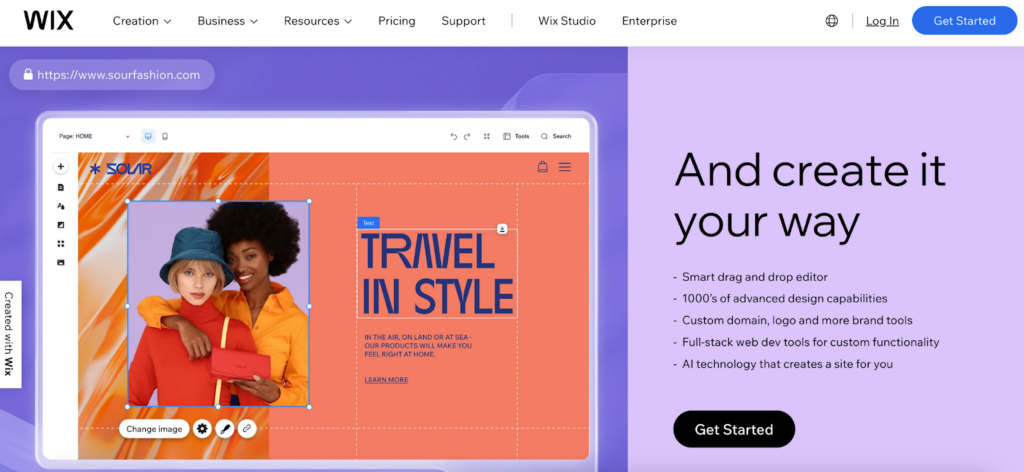
If you’re setting up a blog, you’ll need some funds to set up a blog to pay for your domain name and web hosting or website builder. On the other hand, setting up a YouTube channel or social media account is quick and only needs a little financial investment. However, this option gives you less control over the way it looks.
Step 3. Create Valuable Content
The next step is to create content that will bring readers to your site and then encourage them to click on your affiliate links. You could create blog posts, tutorials, infographics or videos, but it’s important not to make them look like sales posts. Remember that affiliate marketing aims to build trust with your readers, not give them a tough sales pitch.
It helps to make your content as comprehensive and useful as possible so that you become known as an expert in your niche. Then you can work on getting your content to rank in search engine listings, which will require you to pay attention to SEO.
You’ll need to create quite a lot of content when setting up your website and then add to it regularly. Most should be evergreen content, so that it is useful for years to come, but you might want to add in some seasonal content as well. If the thought of creating so much content is overwhelming, you could outsource some of the work to freelancers or use AI tools to help you write content. If you go down the AI route, it’s a good idea to edit the text before you hit publish so that it sounds more like your own writing. To learn more about how to create top-quality content using AI tools, get a free guide from Travelpayouts.
Step 4. Promote Your Content
It’s important to promote any form of content you create to get the best possible reach. The more people you can reach with your content, the higher your earnings will be, so many affiliate marketers share their content on social media platforms. You should also try to stay engaged with your audience on social media and respond to any comments, so you build a reputation as an expert in your field.
You can use paid promotional posts to guarantee that you’ll get good reach on social media, and you can also investigate Google Ads as a way to promote your website. However, be sure to check with your affiliate program first because some don’t allow you to buy PPC ads for their brand name or trademarks. You can read more in our guide to Google Ads for Affiliate Marketing.
Step 5. Track Results and Keep Learning
It’s essential to track your affiliate marketing results so you know what content is working and what isn’t. Installing an analytics tool like Google Analytics will show you important information like how readers find your website, which pages they visit, and how long they spend on each page. You can also register your site with Google Search Console, which will show you the keywords they use to find your site. You can then decide if you’d like to create more content around those keywords or choose content that needs to be updated for better performance.
Affiliate marketing isn’t difficult, but you do need to learn specific skills, and you also need to ensure that you keep up to date with the latest trends and strategies. There are several paid affiliate marketing courses available and or you can gain access to free affiliate marketing courses through the Travelpayouts Academy. Investing your time and a little money in improving your skills will help you to stay ahead of your competitors and keep your business growing.

Which Industries Are the Best for Affiliate Marketing
Choosing the right niche is an essential step in planning your affiliate marketing strategy. You need to find one that has a big enough audience who will find your content engaging and also has enough products or services for you to promote. Remember that one of the best affiliate marketing tactics is to solve problems for your readers, so make sure you can identify plenty of issues for your niche and audience.
Some niches are generally better suited to affiliate marketing, including lifestyle and wellness, technology, travel, and pets. Other popular affiliate marketing niches include gaming, home security, and fashion.
If you want to learn more, click here to read our guide to the best niches for affiliate marketing.
What Affiliate Programs Can You Join
So far, we’ve explained how affiliate marketing works, the types of affiliate marketing models that are available, and the steps you need to follow when setting up your affiliate marketing business.
Now let’s look at some of the most popular affiliate marketing programs you might want to join. Getting your affiliate programs right is vital because most of your affiliate marketing income will usually come from a few core products or services. These four programs are all great programs for new affiliate marketers to consider.
Travelpayouts
Travelpayouts is a digital partnership platform that helps travel bloggers monetize their content. There are over 100 trusted travel brands to choose from, including some of the biggest names in travel, like Booking.com and Viator. When you sign up as a Travelpayouts affiliate, you’ll be provided with a range of tools that allow you to easily set up affiliate links, widgets, and banners.
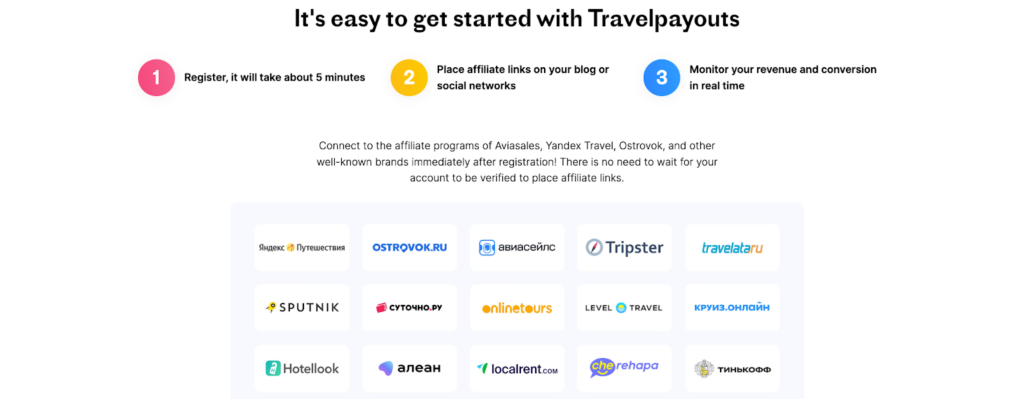
The Travelpayouts publisher dashboard gives detailed statistics on how many bookings you have made, so you always know how much you are earning and which links work well for you. Travelpayouts affiliates also receive free access to the online Travelpayouts Academy, which is full of guides and courses designed to help you maximize your affiliate marketing success. This includes Sharon Gourlay’s highly popular Boost Travel Affiliate Revenue Using SEO course.
Amazon
Amazon Associates is the name of Amazon’s affiliate marketing program, and it has the biggest share of the affiliates market. It’s a great way to start your affiliate marketing journey because they sell millions of products, so you’re sure to be able to find ones that suit your niche and audience.
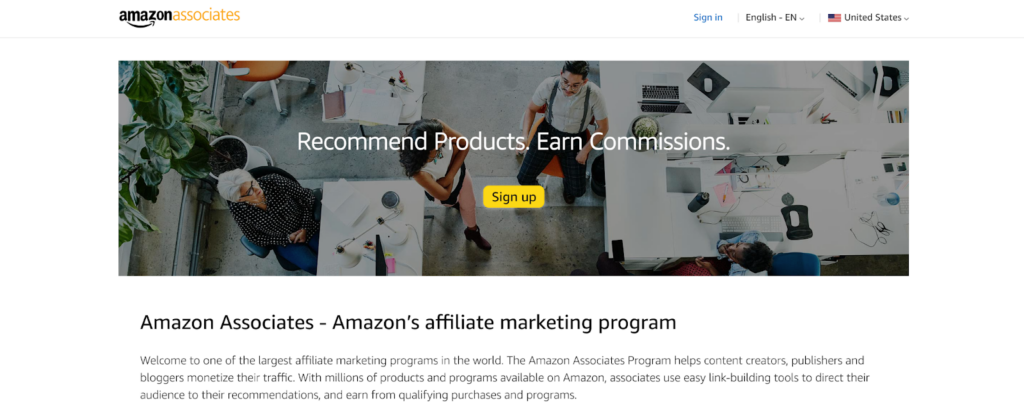
When you sign up for Amazon Associates, you will be given an affiliate ID, and you’ll use Amazon’s custom linking tool to generate affiliate links for each product you want to promote. They also provide banner ads for core products like Kindles and Amazon Prime. The commission value varies depending on the product category and is paid around 60 days after the end of the month in which the qualifying sale was made.
Shopify
Shopify is a very popular e-commerce site that allows entrepreneurs to create online stores quickly and easily. Because selling online is becoming increasingly popular, this affiliate program would be a great choice if your content is aimed at people with entrepreneurial goals.
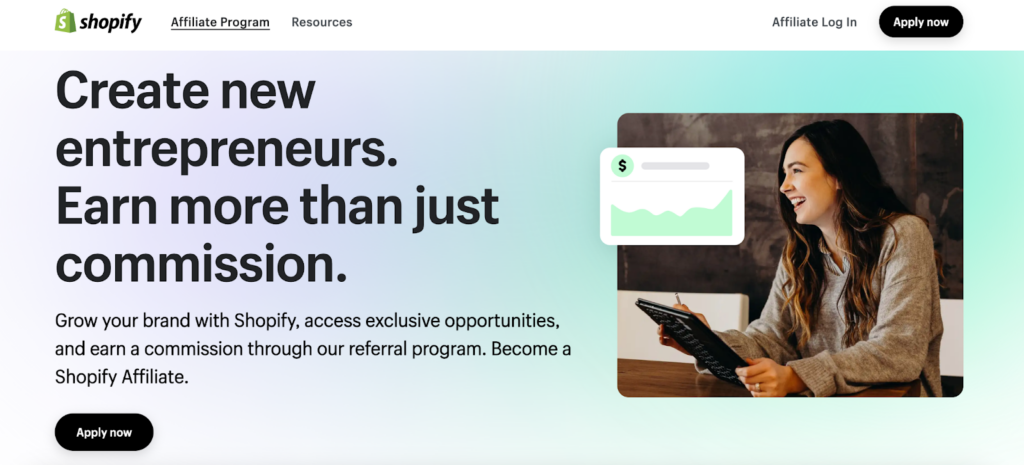
The Shopify Affiliate program has a careful selection process, and approval can take up to 15 days. You’ll need to have an established audience and show that you have already published original content in this niche. This means you may need to wait a while before applying to join this affiliate marketing program. However, once you have been accepted, you can earn a fixed-bounty worth double the monthly plan price for each new client referred through your affiliate link. This is paid bi-weekly when your balance reaches a certain amount.
Rakuten
The Rakuten Affiliate Marketing network is one of the best-performing affiliate networks and has been running for over 25 years. They offer around 1000 affiliate programs from some of the world’s top brands, so you should be able to find something that appeals to your niche. As well as standard text links, merchants can offer ‘Paid Placement’ ads which work like renting out banner ad space on your website.
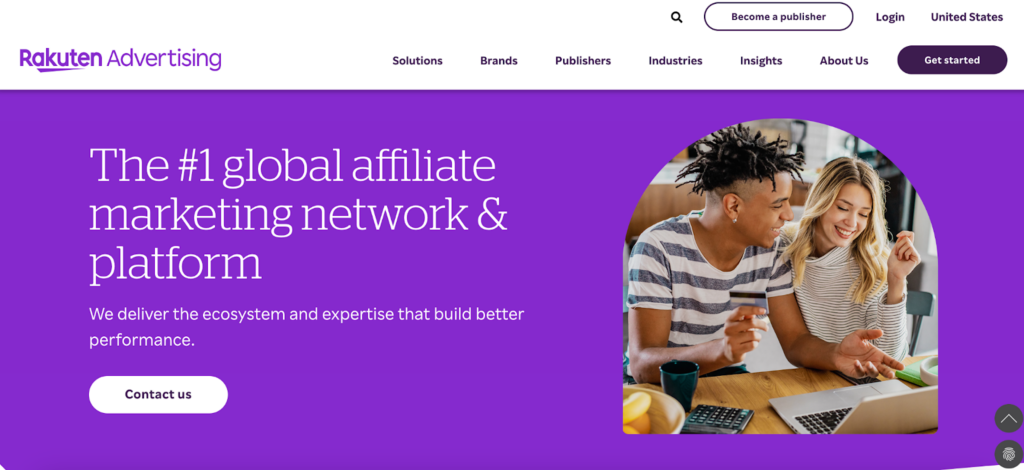
You’ll need to add your website details to your application, so make sure you have a live website with your own domain name and some original content before you apply. Commission is paid around 60 days after the qualifying sale is approved, and there’s a $50 minimum payment threshold.
7 Tips for Affiliate Marketing Success
Once you have picked your niche, set up your blog or social media accounts, and chosen your affiliate products, you’re ready to get started with affiliate marketing. Here are a few valuable tips to help make your business a success:
Tip 1. Create Product Reviews and Tutorials
Affiliate marketing content needs to appeal to people who are pretty far along the buying process. Ideally, you want them to have carried out their initial research and be interested in the specific product or service you’re promoting. Product reviews and tutorials are two great options for affiliate marketing content because they allow you to go into detail about the product’s benefits and show how they can solve your reader’s problems.
A good review needs to feel personal and go into detail about the product. Be sure to show your genuine experiences with the product and let the reader know your candid opinion. If you are open with your reader, they are more likely to feel they can trust you. You can also create tutorials using photos or video, as these can be good for showing your audience how the product will benefit them. ‘How to’ searches are very common, so this kind of content can be effective at drawing traffic to your site.
Tip 2. Build an Email List
One of the major benefits of building your email list is that you have complete control of this asset. Social media platforms can close down or change their algorithm to make it harder for your posts to reach your audience. But if you own your email list, you can easily contact your audience whenever you want. Email has a higher conversion rate than social media because the people who sign up for your email list already trust your opinions and are interested in what you have to say. An email newsletter is also more personal than social media because it turns up directly in the reader’s inbox.
It’s crucial to gather emails in a way that complies with regulations like GDPR in Europe or CCPA in California. Using an email marketing provider like Mailchimp or Mailerlite will help you to do this. You can build your list through your content by offering lead magnets like an e-book or a free course for subscribers. Once you have built your list, you can use your email newsletter to send blog posts, free downloads, special deals, and more. Be sure to check whether the affiliate programs you are promoting allow affiliate links in your email. You may have to add a standard link to content on your site that contains the affiliate link.
Tip 3. Use Relevant Keywords
Even if you create awesome affiliate marketing content, it’s only useful if people can find it. Your need to follow Search Engine Optimization (SEO) guidelines so that search engines will find and add your content to their listings. Ranking higher in search engine listings will make it more likely that people will click through to your content, and that gives your affiliate marketing a boost.
One of the keys to good SEO is choosing the right keywords, which are the words and phrases people use when searching for a solution to their problem. So it’s important to use a keyword research tool to ensure you’re adding these keywords to your content. You can use a paid keyword research tool like Ahrefs or Keysearch, or if you want to keep your costs down, you could try Google Ads Keyword planner. It’s free, but you’ll need to set up an account to use it.
Tip 4. Disclose Your Affiliate Relationships
It’s essential to always let your audience know if you are using affiliate links. Disclosure is not only required by law in many countries but also good business practice. Some worry that disclosing affiliate links will discourage people from clicking on them, but that’s not true. People will respect your honesty and transparency, which will help them trust you more. You can reassure your readers that you only recommend products you are confident they will like and need.
So wherever you share an affiliate link, you must let your readers know that clicking on the link or buying the product will earn you a small commission. You can also add an Affiliate Disclaimer page to your website where you fully explain your affiliate marketing disclosure policy. If you need help with this issue, please seek legal advice.

Each country has its own rules; for example, in the USA, the Federal Trade Commission requires you to let people know before the first affiliate link appears. Even if you aren’t based in the US, you must comply with this if your readers are there. It’s also essential to check what rules your affiliate marketing programs have. For instance, Amazon requires affiliates to display a particular disclaimer on all pages of their website and doesn’t allow affiliate links in emails.
Tip 5. Experiment With Promo Tools and Offers
It’s also a good idea to experiment with different promotional strategies so you can determine what works well with your audience. Your affiliate dashboard and Google Analytics will show you which strategies generate an increase in traffic and conversions.
Some affiliate programs and platforms like Travelpayouts offer a selection of promotional tools to help your marketing efforts.

You could also schedule content at different times of the day or week or create seasonal content to tie in with events like Christmas or Halloween. If one of your affiliate programs offers a bonus or special offer, you should try to find eye-catching ways to promote this to your audience.
Tip 6. Promote a Limited Number of Brands
One of the reasons affiliate marketing works so well is that your audience learns to trust your opinions, and this encourages them to buy the products you promote. So it’s important to build your audience’s trust by limiting the number of affiliate programs you join and only promoting products you really believe in.
Make sure you research the programs and products carefully so your audience will love the products you’re promoting. Choosing products you use and sharing your personal experiences is a great way to ensure your content feels authentic.
It’s also important to stick to your particular area of expertise. If you are a travel blogger, don’t suddenly start adding affiliate links to kitchen equipment or cosmetics just because you see a great commission rate available. This won’t look authentic, and your audience will notice which will damage the trust they have in you and harm your overall success.
Tip 7. Experiment and Test
Some people think that once you’ve set up your website and chosen your products, the hard work is done. But to run a successful affiliate marketing website, you’ll need to monitor your results, experiment with changes and test these changes on your audience.
You could add a different product to your website, sign up with a new affiliate program, or write a different style of content. If you’ve written a review for a product, try filming a video tutorial and linking to that on your site. Or you could arrange to interview an expert to answer questions from your audience.
Whatever changes you decide to make, you need to monitor the results so you know which tactics resonate well with your audience. Then you can focus more on these to generate future success.
Conclusion
This guide has explained all the essential information you need to get started in affiliate marketing. If you’d like to learn more, the Travelpayouts blog has a wide range of useful information, including a guide to the best affiliate programs and how to use affiliate links.
And you can find out more about becoming a Travelpayouts affiliate, including benefits like the online Travelpayouts Academy, by visiting the Travelpayouts digital platform main page.
Affiliate marketing is a great way to turn your dream of earning online into a reality. You will need to put in some work, and it’s vital to maintain your authenticity so that you don’t damage the relationship of trust you build with your readers. But there’s almost unlimited opportunities for earning and with the right knowledge and persistence, you can make your affiliate marketing business a great success!
Affiliate Marketing: FAQ
If our guide hasn’t answered your question yet, here are a few of the most frequently asked questions about affiliate marketing.
Can I Turn Affiliate Marketing Into a Career?
Affiliate marketing is a very satisfying and successful career for many people. You may not see financial success right from the start, but with time and effort, you can certainly make a career in affiliate marketing. It will take dedication to stay focused on your goal and create high-quality content consistently.
How Much Money Can I Make With Affiliate Marketing?
Your earnings will vary depending on your affiliate marketing model, the value of the items you promote, and how much effort you put into the process. If you pick the right niche and products and put in the effort to attract visitors to your site, you could earn anything from a few hundred dollars to thousands of dollars every month.
How Do You Find the Best Products for Affiliate Marketing?
Getting to know your audience and discovering which products and services they need is essential. Then you can investigate which brands offer affiliate marketing programs for these. Market trends will also be a significant factor, so look out for any trends your audience is interested in. Try to react quickly to these trends and create the content that makes your site the go-to for product reviews or tutorials.
How Do You Pick an Affiliate Marketing Niche?
Picking the right niche is essential for affiliate marketing success. You need to choose one where there will be good demand for the products and services, and where you can make a profit.
So think about your interests and passions, and identify the problems you can solve for your readers. If you can work out their problems, and what products or services will solve these issues, that will help you run a successful affiliate marketing business.
What Are the Top Affiliate Networks?
As well as the affiliate programs mentioned earlier, you might also want to check out some of these affiliate networks:
● Travelpayouts
● Awin
● AvantLink
● CJ Affiliate
● ClickBank
● FlexOffers
● LinkConnector
● ShareASale




